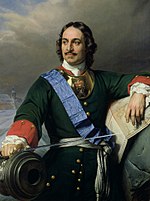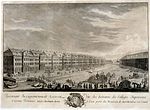Search results
Appearance
There is a page named "Government reform of Peter the Great" on Wikipedia
- The government reforms of Peter I aimed to modernize the Tsardom of Russia (later the Russian Empire) based on Western European models. Peter ascended...15 KB (1,900 words) - 23:27, 13 November 2023
- The Church Reform of Peter the Great was a set of changes Tsar Peter I (ruled 1682–1725) introduced to the Russian Orthodox Church, especially to church...12 KB (1,562 words) - 06:04, 6 May 2024
- The Government reforms imposed by Tsar Alexander II of Russia, often called the Great Reforms (Russian: Великие реформы, romanized: Velikie reformy) by...36 KB (4,850 words) - 12:51, 15 June 2024
- of Imperial Russia. Peter the Great introduced the system in 1722 while engaged in a struggle with the existing hereditary nobility, or boyars. The Table...21 KB (1,119 words) - 12:27, 29 June 2024
- portrait of Peter the Great by Paul Delaroche, c. 1838, Hamburger Kunsthalle collection Government reform of Peter the Great History of Russia (1721–96)...103 KB (11,475 words) - 15:52, 28 June 2024
- portal Church reform of Peter the Great Digest of Laws of the Russian Empire Government reform of Peter the Great Government reform of Alexander I His...24 KB (2,081 words) - 16:32, 5 June 2024
- The Representation of the People Act 1832 (also known as the Reform Act 1832, Great Reform Act or First Reform Act) was an Act of Parliament of the United...72 KB (9,216 words) - 04:42, 30 June 2024
- Collegium (ministry) (category Government reform of Peter the Great)The Collegium (Russian: Коллегии, lit. 'joined by law') was a type of government department in Imperial Russia. It was established in 1717 by Peter the...8 KB (853 words) - 11:07, 24 June 2024
- more as a phenomenon of the future, the latter believed that government reform of Peter the Great did not meet the traditions of a Russian civilization...7 KB (582 words) - 21:34, 6 August 2023
- Government of India Act of 1909)The Indian Councils Act 1909 (9 Edw. 7. c. 4), commonly known as the Morley–Minto or Minto–Morley Reforms, was an act of the Parliament of the United Kingdom...13 KB (1,315 words) - 02:38, 26 June 2024government-initiated or government-backed property redistribution, generally of agricultural land. Land reform can, therefore, refer to transfer of ownership...26 KB (3,128 words) - 13:30, 27 May 2024The early Russian system of government instituted by Peter the Great, which consisted of various state committees, each named Collegium, was largely outdated...3 KB (316 words) - 00:18, 3 June 2024
- House Government Reform Committee)the duties of the seven subcommittees into five. In the 106th Congress, the panel was renamed the Committee on Government Reform. While retaining the...46 KB (2,646 words) - 22:55, 18 June 2024
- Peter the Great and the Rise of Prussia 627053Lectures on Modern History — XVII. Peter the Great and the Rise of PrussiaJohn Acton XVII PETER THE GREAT
- improve the system, but try to overthrow whether it be the government or a group of people themselves. REFORM, v. A thing that mostly satisfies reformers opposed
- by the Great Depression of the 1930s. The Conservative coalition Government failed to get New Zealand out of the Depression, which led to the rise of the
)










